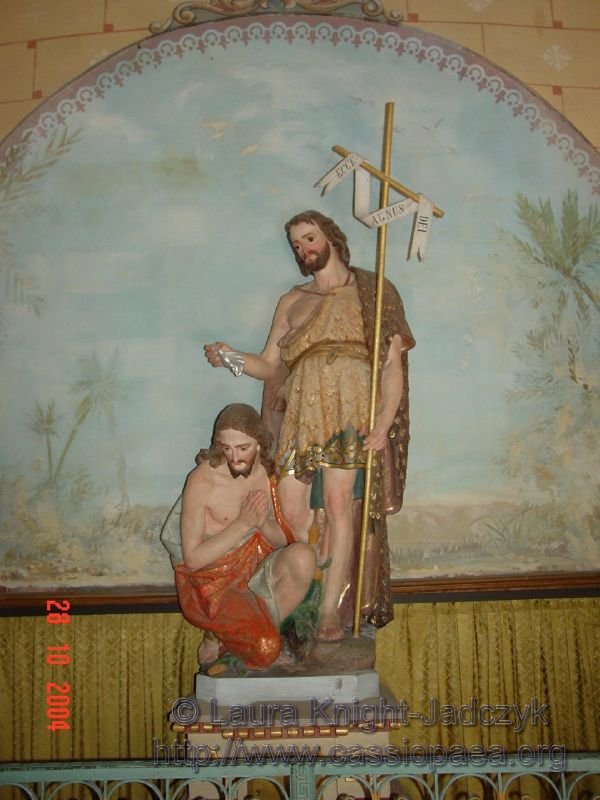The Quantum Future School Goes to Rennes-le-Chateau (29 of 68)
![[First]](bw_first.gif)
|
![[Prev]](bw_prev.gif)
|
![[Index]](bw_index.gif)
|
![[Next]](bw_next.gif)
|
![[Last]](bw_last.gif)
|

|
|
Even though many people pronounce these statues of Abbe Sauniere to be tacky, we rather liked them. After all, if you are a village priest in an out of the way place on top of a hill, what else do you have to do but decorate and make your exile pleasant? In any event, John the Baptist stands over someone whom he is apparently baptising. We are supposed to infer that the person is Jesus. What is most peculiar is that John is dressed as a Roman. Some have suggested that the person receiving the baptism appears to be assuming almost the exact position of the devil near the door, but that is a real leap in my opinion. How many ways can you kneel? St. John the Baptist has two commemoration days. The first is the 24th June which marks his birth and the second, which was adopted sometime after 1801, marks the date when he was beheaded, the 29th August. The following account is from a medieval source: "Reynaldus: On the Accusations Against the Albigensians." ("Albigensians" was another name for the Cathars.): First it is to be known that the heretics held that there are two Creators; viz. one of invisible things, whom they called the benevolent God, and another of visible things, whom they named the malevolent God. The New Testament they attributed to the benevolent God; but the Old Testament to the malevolent God, and rejected it altogether, except certain authorities, which are inserted in the New Testament from the Old; which, out of reverence to the New Testament, they esteemed worthy of reception. There is no surviving version of the Cathar New Testament, so we are without any idea of what, precisely, they did include as being valid. We do think that the Gnostic gospels are, very likely, if not the same, similar, to the Cathar texts. We do know that they esteemed the gospel of John as being the "closest" to the truth, and that they considered the "historical" gospels to be all "made up" stories that had nothing to do with the "real" Jesus. Reynaldus further tells us: They charged the author of the Old Testament with falsehood, because the Creator said, "In the day that ye eat of the tree of the knowledge of good and evil ye shall die;" nor (as they say) after eating did they die; when, in fact, after the eating the forbidden fruit they were subjected to the misery of death. They also call him a homicide, as well because he burned up Sodom and Gomorrah, and destroyed the world by the waters of the deluge, as because he overwhelmed Pharaoh, and the Egyptians, in the sea. This is quite clearly a Gnostic idea. The Gnostics taught that Jehovah/Yahweh was an "Evil God" more like a demon than anything else. But, a part of their teaching as well was that he did have something to do with the creation of the material world. So, he clearly wasn't just a "demon" in the sense of an ethereal attacker of human beings who could be "cast out" by an exorcism. No, indeed, he was far more than that! He was a hyperdimensional being of great power and cunning! Again, from Reynaldus: They affirmed also, that all the fathers of the Old Testament were damned; that John the Baptist was one of the greater demons. This is an interesting remark since it relates in a curious way to a comment of "Jesus" in the Secret Book of James. His disciples are asking him: "Lord, how can we prophesy to those who ask us to prophesy to them? For many people ask us, and they expect to hear a sermon from us." The Lord answered and said: Do you not know that the head of prophecy was removed with John? When you realize what the head is, and that prophecy comes from the head, then understand what this means: its head was taken away. At first I spoke with you in parables, but you did not understand. Now I am speaking with you plainly, and you still do not perceive. This is, no doubt, an extremely mysterious remark. Writers of the present day, not understanding the symbolism of the "talking head" and the head of John the Baptist as it relates to the head of Bran the Blessed, the Ark of the Covenant, and the Holy Grail, have erroneously come to the conclusion that John the Baptist was the true object of worship of the Cathars and Templars. [Picknett and Prince.] Some writers have even ignorantly proposed that this "talking head" is the armillary sphere of Pope Sylvester, and that it "talks" about "precessional cycles." It is quite probable that the remark of Raynaldus about the condemnation of John the Baptist by the Cathars has some foundation in fact. If so, what are we to make of the claims of those who propose that there has been a secret society for millennia that actually worships John the Baptist and Mary Magdalene in secret? Certainly, if that had been the case with the Cathars, Raynaldus would have said so because such a claim was damning enough in its own right. But that is not what he said. He said that the Cathars damned John the Baptist as one of the greater demons. And then we see the "Jesus" of the Gnostic texts saying that the head of this "demon" had been related to "prophecy" and was "removed." |
![[First]](bw_first.gif)
|
![[Prev]](bw_prev.gif)
|
![[Index]](bw_index.gif)
|
![[Next]](bw_next.gif)
|
![[Last]](bw_last.gif)
|